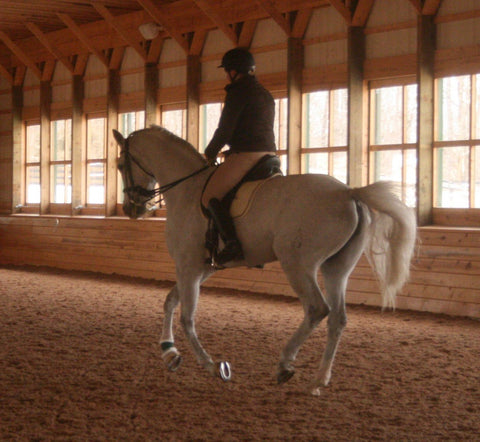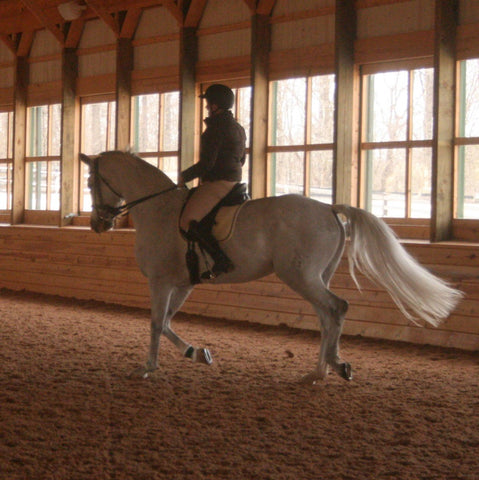Introduction to Saddle Fitting
Good Saddle Fit from the Start
Trees, Panels, and Motion
Saddle Fitting and Panel Design
Saddle Trees
More About Saddle Trees
Custom Saddle Fit. What Does it Mean?
When fitting a saddle to a horse, it is critical to understand that the horse’s back changes shape. It changes shape over the span of the horse’s life, and it changes shape while being ridden. In fact, the shape of the horse’s back changes continuously throughout the horse’s range of motion, so riders should be encouraged to grasp for a deeper understanding of saddle fitting in terms of the physics of dynamic weight-bearing and the geometry of matching bearing structure to bearing structure.
Saddle fitting is a tradition-bound field, often approached as a process of working through a checklist of visible features to ensure that they comply with a list of traditional saddle fitting rules. In practical terms, these “rules” may sometimes help to identify problems with the fit of a saddle, but they are rarely helpful in identifying solutions. A more practical, science-based approach to saddle fitting should encourage riders to grasp for a deeper understanding of saddle fitting in terms of dynamic weight-bearing.
There are some useful parallels between fitting an athlete’s foot correctly in a pair of running shoes and fitting a saddle to a horse’s back. There is widespread understanding these days that a human athlete’s foot deforms — it changes shape — each time it is loaded during foot strike. Active motion such as running and jumping produce a higher kinetic load on the athlete’s foot (and the horse’s back) than standing still. Obviously, running shoes require some tolerance for this effect to ensure the comfort and long-term soundness of a human athlete.
When I fit a saddle to a horse, my aim is to find a fit solution that will allow him to be as comfortable in his saddle as my feet are in my running shoes. Perhaps the questions we should be asking when we select a saddle for a horse are:

One major difference between ridden horses and human runners is that human feet were purpose-made for running, and horse’s backs were not made to withstand the dynamic impact (mass times velocity) of a rider. We know from common sense, from Newton’s laws, and from the scant scientific research available on saddle fitting, that the rider, who is a separate body in motion when the horse is moving, generates a considerable dynamic load on the equine back. The impact the rider creates varies from one phase of motion to another, both in the intensity of the force created by the rider’s body in motion, and also in how that impact is distributed over the bearing structure of the saddle, and over the horse’s back. Because the pattern of impact is different in trot, for example, than in canter, understanding the pattern of impact in a saddle is more complicated than understanding a runner’s foot strike.

The horse and rider are independent bodies in motion. The stirrup bars, which are riveted to the saddle tree, are a structural component of the saddle that enables the rider to arrest her own forward momentum on the landing side of the jump. The transmission of this kinetic force creates a brief but dramatic impact on the horse’s body. This transmission of force through the structure of the saddle is less extreme during the trot and canter, but unlike the effect of a jump landing, it repeats continuously with every stride.
Clearly, a good fit for the horse at the stirrup bars is absolutely vital, though nearly always glossed over in “conventional” saddle fitting. As with good running shoes, optimal saddle fit solutions must allow an appropriate tolerance for the horse’s back to change shape throughout the range of motion. From here forward, however, saddle fitting becomes a lot less straight-forward than fitting shoes for several reasons:
Not surprisingly, most of us riders find it easier to identify what we like or don’t like about a saddle for ourselves than it is to determine whether or not the saddle is a “good enough” fit for our horse. While marketing in the saddle industry stresses the many advantages of particular saddles for the rider, the rider is almost never offered a “peek under the hood” that would help to convey an accurate, detailed understanding of whether a particular saddle would likely be a suitable match for a particular type of horse.
Saddle design and manufacturing tend to be quite tradition-bound. With some exceptions, the industry as a whole has not been favored by advances in technology or in research to the same degree as some other sports, where equipment has undergone continuous refinement.
Good saddle fitting practice is much more than a process of going through a standard checklist to determine whether a saddle appears to fit while a horse is standing in the barn aisle. It can be helpful in our effort to ensure their comfort and soundness to move beyond the traditional checklist of superficial saddle fitting features that are determined by the external, visible aspects of saddle fit. It is relatively easy to identify fit flaws in most saddles with the horse standing still without a rider, but to confirm that a saddle performs well in motion involves riding.
For a deeper understanding of the saddle’s real tolerance, we need more knowledge about the geometry and fit characteristics of the tree, which is the saddle’s internal load-bearing structure.
Introduction to Saddle Fitting
Good Saddle Fit from the Start
Trees, Panels, and Motion
Saddle Fitting and Panel Design
Saddle Trees
More About Saddle Trees
Custom Saddle Fit. What Does it Mean?